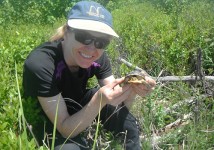Every year more than 500 turtles are brought to the Kawartha Turtle Trauma Centre (soon to be the Ontario Turtle Conservation Centre) with life-threatening injuries, usually because they have been hit or run over by cars. That’s bad news, since seven of the eight species of turtle found in Ontario are endangered. Ontario Veterinary College graduate Sue Carstairs, who is director at the centre, says the eighth is at risk as well.
“When turtles lay eggs in the wild, only about one per cent survive,” says Carstairs, who also provides veterinary services at the centre. “In the wild, that works out OK because the adults live a long time and have few natural predators.” But with increasing traffic on the roads and diminishing wetlands, the survival of these unique animals is threatened.
Carstairs has always been interested in conservation and wildlife. In addition to her work at the turtle centre, she has worked as a veterinarian at Toronto Wildlife Centre and Earth Rangers Wildlife Centre. She also teaches vets and vet technicians about the care of turtles and other wild animals. “Once you know how to treat them (turtles), they can recover from quite severe injuries.”
Turtles are critical to the biodiversity of Ontario’s wetlands, which serve as the filters for our entire water system. “Turtles clean up dead fish and eat insect larvae, and their babies provide food for other species,” says Carstairs. “They open water channels for smaller fish and help keep the whole wetland functioning.”
She adds: “They are amazing creatures. They can survive when hibernating on very little oxygen and some can survive at below-freezing temperatures. The females can store sperm for years until they are ready to produce eggs. They grow throughout their entire lifespan. Their way of life has worked for them for 200 million years — until we came along with our cars.”
Because turtle injuries happen in various parts of the province, Carstairs has connected with local veterinary clinics that can provide first-aid and stabilize the turtles, and a network of volunteer drivers who help to transport the injured animals to the Kawartha Turtle Trauma Centre. And not just drivers: she recalls a turtle found injured near Sarnia, Ont., which was taken to a local rehab centre. When a driver couldn’t be found to transport it, a pilot offered to fly the turtle to Peterborough where Carstairs successfully treated the animal.

Turtles are always released close to the spots where they are found. “There are very distinct genetic populations within each turtle’s territory,” Carstairs explains. “There is also the risk of introducing new diseases if you put the turtle in a new location.”
Her busiest season is in June, because female turtles are on the move looking for good spots to lay their eggs; Carstairs and her team expect to hatch more than 1,000 baby turtles this year, all from eggs collected from injured or deceased turtles. They are also raising baby turtles born to injured females, hoping their chances of survival will improve if they are bigger and stronger when released. Once released, the centre tracks them via radio telemetry, along with a group of wild turtles, to compare behaviour and survival.
Carstairs is also focused on preventing turtle injuries. In addition to posting more warning signs for drivers, the centre also participates in road mitigation projects to provide eco-passages (a means to cross under a road) for turtles. “Road ecology is a rapidly developing field, and is the gold standard in preventing road mortalities,” she says. Meanwhile, the centre’s education program helps motivate stewardship practices that help prevent all causes of population declines.
